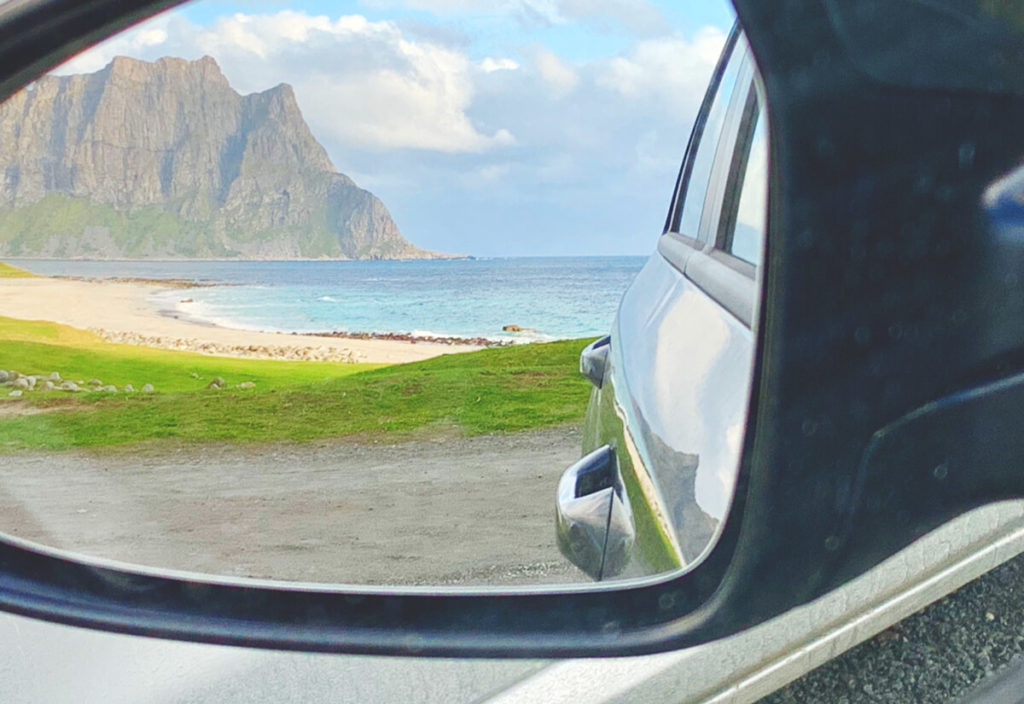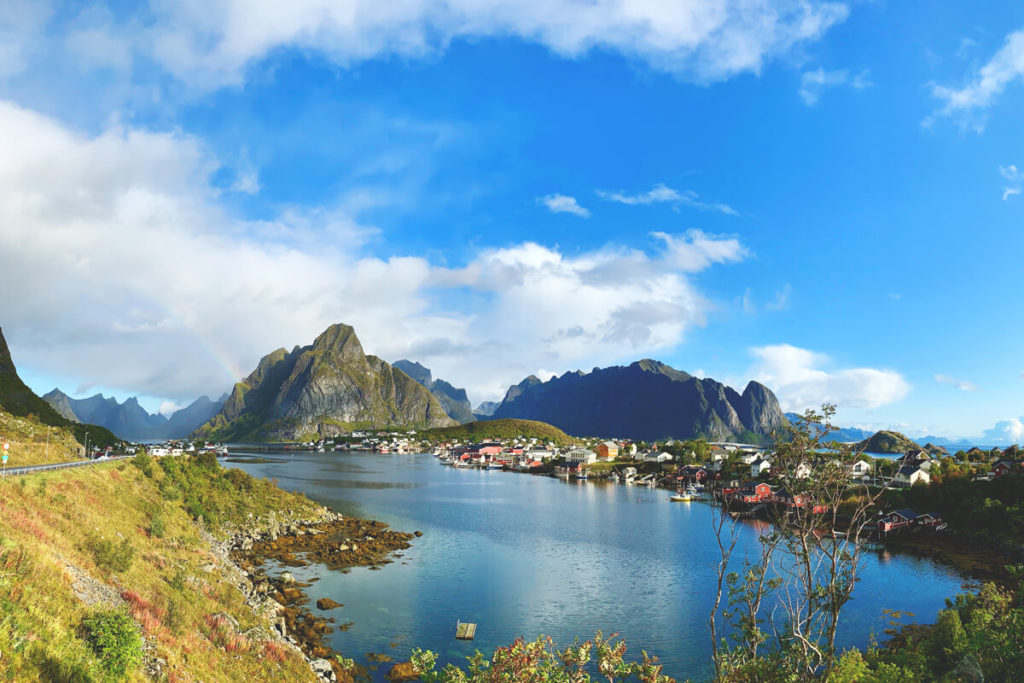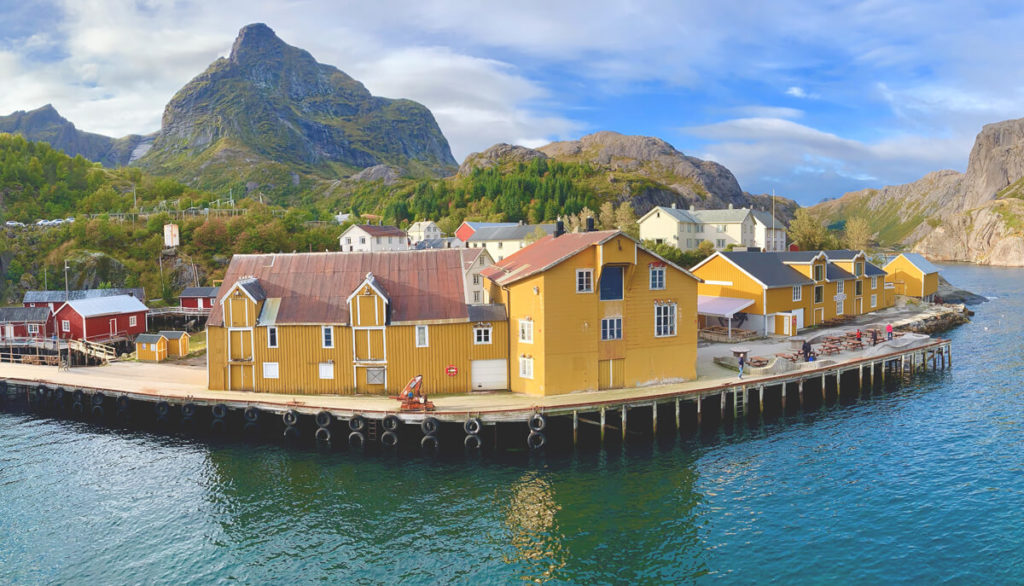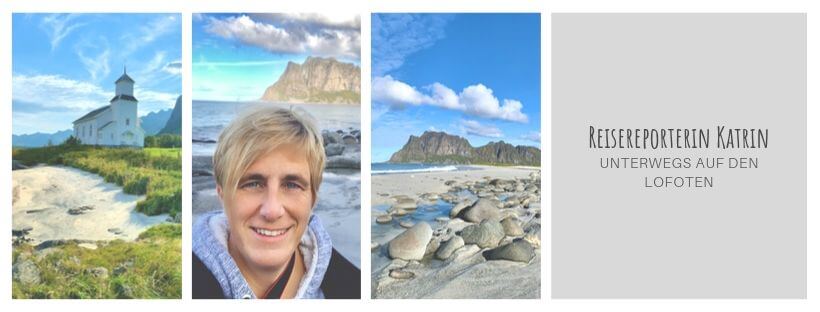Our lovely travel reporter Katrin is taking us to the beautiful Lofoten Islands in Norway today. But beware: Wanderlust is guaranteed! Katrin reports on the charm of the Lofoten Islands despite overtourism, on their most beautiful highlights and underrated spots, as well as on Arctic surfing, mesmerizing northern lights, and picture-perfect fishing villages. We are absolutely blown away, and are about to pack our backpacks and head off to Northern Norway. The Lofoten Islands are now even more popular with us than they already are. We hope you enjoy reading and following along!
- Welcome to the Lofoten Islands in Norway
- Defying overtourism
- From A to B by car
- Lofoten Highlights – Top Spots
- Lofoten Highlights – What to do
- Lofoten Highlights – Where to go
- Underrated Spots
- Conclusion on the Lofoten Islands
- Getting to Lofoten
- Booking accommodation
- Best time to visit Lofoten
Welcome to the Lofoten Islands in Norway
Caribbean-like beaches with turquoise-blue water and spectacular mountain ranges in the background, deeply indented fjords and picturesque fishing villages nestled in wonderful bays: Welcome to the Lofoten Islands. Approximately 25,000 people live on the Lofoten archipelago in northern Norway, in the Nordland county, hundreds of kilometers above the Arctic Circle. The first settlers named it Ló (Old Norse for lynx) fot (the foot) because, from the air, the archipelago looks like the giant paw print of a wild cat in the sea.

Defying Overtourism
Today, the days of the first settlers are long gone, and the region is struggling with the increased tourism of recent years: approximately 1 million visitors flock to an area of 1227 km² every year. For a long time, the Lofoten Islands were considered an insider tip for nature lovers willing to overcome obstacles such as the long journey or the poor infrastructure. The archipelago is definitely no longer an insider tip. Is the trip still worthwhile? What makes the Lofoten Islands so charming, and how can you still experience unique natural experiences in secluded nature despite overtourism?
Take your time
The “Norwegian Scenic Route Lofoten” runs between Å and Raftsundet (E10) with detours to Nusfjord (road 7596), Vikten (road 7600), Utakleiv (roads 7606-7716), Unstad (road 7720), Eggum (road 7724), and Henningsvær (road 816). The route has a total length of 230 km. So you might think that a two-day trip is completely sufficient for visiting the Lofoten Islands. Uh, no!

If you want to experience the top spots without the crowds, you may have to resort to alternative times of day. If you want to enjoy the stunning natural scenery in special lighting conditions, you’ll have to visit places at sunrise or sunset. If you’re looking for “hidden gems,” you’ll need to lace up your hiking boots. So: plan 7-10 days for your Lofoten trip and you’ll have an unforgettable experience in the far north of Norway!
Choose your travel time carefully
In the summer months, it’s not just many foreign tourists who travel to Lofoten. Norwegians also love this spot, and we were told that during the Norwegian holiday season, the E10 highway is like a traffic jam. Yes, summer offers wonderful Midsummer days and nights. But why not enjoy the vibrant colors of the (short) autumn in Lofoten? Or marvel at the red wooden houses of the fishing villages set against the snow-capped mountains? Not to mention the possibility of seeing the Northern Lights… We were in Lofoten in mid-September and can highly recommend this time of year!

Leave the E10
The E10 is a wonderful road, no question. It takes travelers “comfortably” to the top spots of the archipelago. The price of convenience is then paid in overcrowded parking bays or picnic areas that you suddenly find yourself sharing with a busload of photo tourists. What to do? Buy a good road map and deliberately take alternative routes! Stop in small, sleepy towns and strike up a conversation with the locals. Attentive, polite tourists are always greeted with kindness, and you might even get an insider tip or two from a local.

From A to B by Car
Perhaps I should have started this article differently… because, as you may have noticed, I’ve automatically assumed in my previous comments that you’re traveling by car. This is because a car provides the necessary mobility for an intensive exploration of the archipelago. You don’t need to be afraid of the combination of the words “archipelago” and “car,” as all areas are connected by (sometimes adventurous) bridges.
Yes, there are public buses and many ferry connections. And yes, we saw hitchhikers. Yes, you can cycle or hike through Lofoten. However, my recommendation is to travel by car. By car, it’s almost 2,000 km from Cologne, for example, to reach Lofoten. Therefore, we opted for a flight to Evenes, where we picked up a rental car. You’ll find your way to Lofoten, I’m sure of it. You’ll find more information on how to get there below.
Lofoten Highlights – Top Spots
But what is there to explore? I’ve divided a few recommendations for you into the sections “Top Spots,” “What to Do,” “Where to Go,” and “Underrated Spots.” By “top spot,” I mean a place that attracts an above-average number of tourists. But what makes these places special? Are they worth a visit? More on this in the following sections…
The fishing village of Reine
If you enter the keyword “Lofoten” into popular internet search engines, many images of Reine immediately appear. This former fishing village has existed since 1743 and, with its numerous rorbuer (cottage houses), still demonstrates why people settled there back then: to catch fish. The famous red or yellow wooden houses, perched on stilts and clinging to every possible rock formation, made it possible to harvest cod stocks, particularly in an area that at the time hardly conducive to year-round settlement. The word rorbu is composed of the words “ro” (rowing) and “bu” (living). Today, almost all rorbuer (plural) have been converted into tourist accommodations.

Reine has a wonderful location and is especially known for its local mountain, Reinebringen. You’ve probably seen photos from dizzying heights, showing incredible views of Reine, the fjords, and the incredible mountain ranges. If you’re athletic and have a head for heights (two attributes that don’t really apply to me) – let’s go! It’s definitely a top spot! You only have to climb about 1,500 steps of a Sherpa staircase, and you probably won’t be able to enjoy the view in solitude, as this spot was extremely busy even in September! We preferred to visit the small village and strolled among the numerous Rorbuer (traditional Norwegian huts).

°A – The last inhabited village in Lofoten
°A is not only the last letter in the Norwegian alphabet but also the last inhabited village in Lofoten. A visit is definitely worth it! Å is primarily a fishing village museum and consists of 23 buildings, 150 years old and still in their original location. These include several rorbuer (cottage houses), boathouses, a blacksmith shop, a bakery, and a blubber factory. The blubber factory was disgusting, but the rest is really interesting and worth seeing. We were particularly impressed by the bakery – they serve what are arguably the best cinnamon rolls in the region in an authentic setting! We skipped the stockfish museum, but it’s certainly interesting for those interested in learning about the harsh conditions of cod fishing.

Henningsvaer – Venice of the North
Henningsvaer is located on eight islands connected by bridges. I read in a travel guide that this is why it’s also called “the Venice of the North.” Nonsense, in my opinion. There’s hardly a more classic fishing settlement than Henningsvaer – you’re constantly stumbling across drying racks of fish throughout the town.
Nevertheless, the island is well-equipped for tourists, with numerous cafes and galleries. Many, like us, are particularly drawn to the local soccer field, which boasts a truly spectacular location! An aerial photograph of this field was honored by National Geographic, and suddenly the training location has achieved hip status for almost 30 club members.

Lofoten Highlights – What to do
What do you actually do in Lofoten? Besides the spectacular nature, are there certain activities that can be done here/only here? The Lofoten Islands offer a variety of adventures, whether leisurely or action-packed.
Brrrrr – Arctic Surf
Are you sporty, love the water, and maybe even count surfing among your hobbies? Then you should definitely join the “Arctic Surfers” at Unstad Beach. The scenery is dreamy, and the waves are pretty good! The only drawback: the water temperature… Even if you don’t want to surf yourself, watching and the beach are definitely worth it! If I ever get the idea to surf, this is my place to be!

Take a boat trip
You’re surrounded by wonderful fjords! So what could be better than hopping on a boat and letting yourself be taken deeper into these fjords? You’ll find the opportunity for such a boat trip in almost every town. You can usually choose between a real “boat” or a speedboat, where you can be strapped into your seat and driven quite close to the spectacular fjord walls. The most famous boat tour is certainly a trip into the “Trollfjord,” which starts from Svolvaer.

You have to expect costs of around €100 and a bit of luck to snag a spot (at least in the off-season). We weren’t so lucky and instead drove from Reine across the Reinefjord. It was fantastic, even though the weather wasn’t great that day. You can book the tour as a round trip or have it dropped you off in the morning at one of the isolated villages nestled in the fjord arms and pick you up again in the evening after a wonderful hike. Absolutely unforgettable!

Seeing the Northern Lights
When you come to Lofoten in the fall/winter season, there’s one very special thing that comes to mind when it comes to “what to do”: hunting for the Northern Lights! We were incredibly lucky and saw the Northern Lights on four consecutive nights in mid-September. Nights I will never forget! I wish every traveler could have this experience: when the sky above you starts to move and you are surrounded by dancing green lights. This feeling is hard to describe in words… so here is one of my favorite photos from a night on the cliffs of °A:

Lofoten Highlights – Where to go
Which places or activities shouldn’t you miss beyond the “top spots”? I’ll introduce you to three of my favorites in more detail, and I’m sure you’ll find one or two of them during your trip.
Museum Village Nusfjord
Nusfjord is one of the oldest fishing villages in the Lofoten Islands. 28 19th-century buildings provide a magnificent backdrop, and their state of preservation justifies the title of “museum village” and the associated entrance fee. In summer, the influx of tourists here must be enormous; in the off-season, the village, sheltered from the wind in a narrow harbor basin, seems rather quiet and sleepy. Perhaps my favorite place on this trip…

Hiking
Anyone visiting the Lofoten Islands will hopefully have packed their hiking boots! Because the most beautiful places, away from the “top spots,” can definitely only be reached on foot. The best hiking trails usually lead steeply uphill. But you’ll be rewarded with breathtaking panoramas that make up for every rocky meter of elevation!
A wonderful path that runs almost at ground level and is therefore also suitable for those who don’t like hiking is the coastal path between Haukland Beach and Uttakleiv Beach. An absolute highlight! Haukland Beach captivates with its large sandy bay and unreal turquoise water. On the right of the picture, you can see the mountain around which the hiking trail to Uttakleiv Beach climbs.

You’ll have a magnificent view back to the sandy beach, and as you walk around the mountainous promontory, you’ll be rewarded with one of the most beautiful beaches in the Lofoten Islands (in my opinion). In addition to a large bay, Uttakleiv also boasts stunning cliffs on the beach and a stunning mountain range. And: if you want to skip the hiking trail, you can also reach the beach through a somewhat spooky single-lane tunnel.

Viking Museum
Definitely a place worth visiting, and not just on rainy days! In 1986, an Iron Age longhouse from the 6th century was excavated near Borg. Today, its reconstruction forms the basis of the Lofoten Viking Museum. There’s also a modern museum building that displays additional original finds and, with these everyday objects, gives you an insight into life at that time. The museum’s outdoor area includes a circular hiking trail with an animal enclosure, and by the fjord, there are replicas of Viking ships that even set off for joyrides into the fjord during the summer months!

Underrated Spots
Okay, let’s move on to a section I’ve been thinking about a lot. Should I even tell you about these spots? Or should I keep them to myself? Here we go…
The small island of Gimsoya
If you persistently follow the E10 south, you can drive past one or two gems. The rather small Lofoten island of Gimsoya is a classic case in point. On the E10, you spend just four kilometers on the island before you’ve crossed the next bridge and arrived on the neighboring island of Vestvagoya. Mistake! Because Gimsoya enchants travelers with a stunning 27-kilometer panoramic road! Turn off and visit the Gimsoya Church with its incredible sandy beaches.

And plan a longer stop to enjoy Hov Beach. Beautiful sandy beach, clear water. For the campers among you: there’s a campsite here with an incredible panorama and a sauna barrel that offers ocean views and maybe even a glimpse of the Northern Lights at night!

The dropout cult in Vikten
To reach Vikten, you have to leave the E 10 again and drive to the very northwest of the island of Flagstadoya. The place is known for a dropout cult called “Guds Menigheit” and for a glassblowing workshop. What is this craft doing on a stretch of coast that appeared wild and windy to us? Quite simply: the floats for fishing nets used to be made of glass!
It wasn’t until the 1970s that Vikten began producing art glass, which can be visited during the high season, including a studio, showroom, and café. Otherwise, the town offers magnificent views of the rough sea, and above the town, you can hike to a small mountain lake.

Lonely sandy bays in Myrland
Here in Myrland, there’s essentially “only” nature. But since a gravel road leads to it, few travelers stray into this remote corner of the Lofoten Islands. And that, in turn, is what makes it so special. No café, no attraction. Only secluded sandy bays and wonderful views of the surrounding mountain ranges. For hikers: there’s a hiking trail that takes you to Vikten!

Conclusion on the Lofoten Islands
Yes, despite overtourism, the Lofoten Islands are still a worthwhile destination. This corner of Norway is blessed with so much wonderful nature that it’s worth the long journey. Avoid the peak season and take more remote routes, and you’ll have a unique travel experience! Have fun!

Getting to Lofoten
Are you inspired to follow in Katrin’s footsteps and visit the Lofoten Islands? There are no direct flights from Germany; you have to fly to the Lofoten Islands via Oslo. From Oslo, you can continue on to the far north with airlines like SAS, Norwegian, or Widerøe. But hey, how about a stopover in Oslo? Explore this cool metropolis on your own before continuing your journey. The flight from Oslo to the Lofoten Islands via Bodø (or Harstad/Narvik/Røst/Evenes) takes just under two hours. From there, smaller vehicles will take you on to Svolvær or Leknes, which takes 20 to 30 minutes.
Of course, you can also plan a road trip and travel by car. However, the distance is quite long, so you should consider this undertaking carefully. From Berlin to Svolvær is 2,428 kilometers. Ferry connections, toll roads, and high fuel costs await you on this route. Nevertheless, this method of travel is ideal for globetrotters, as you pass through some great cities along the way. From Oslo, you can even take the train to Trondheim and then on to Bodø (17 hours). From Bodø, however, you will need another ferry, plane, bus, or rental car to get to Lofoten.
Booking Accommodation
Of course, you also need suitable accommodation(s) for your Lofoten trip. It’s best to simply browse the Booking.com* and Airbnb* platforms. You’ll find a wider selection of options there. If you’re traveling to Lofoten during peak season, you should book your accommodations in advance. Make sure your stay isn’t too far off the beaten track, but closer to the E10. Accommodations with a kitchen are best, so you can cook your own meals and save a few euros on restaurant visits.
Best time to visit Lofoten
So, when is the best time to visit Lofoten? The Lofoten Islands are located between 100 and 300 km from the Arctic Circle. You can probably imagine that up here in the north, the weather isn’t exactly like Mallorca. The best time to travel for your vacation in Lofoten is in July and August. But it’s also peak season, which means there’s a lot more going on, and prices skyrocket. It’s better to take advantage of the off-season!
The off-season in May, June, September, and October is also ideal for a trip to Lofoten. You should bring some warm clothing and prepare for temperatures between 8°C and 10°C. As always, no one can guarantee “great” weather. That’s entirely up to the weather gods.
Although Lofoten is located on the same latitude as Northern Siberia and Greenland, the Gulf Stream means temperatures are mild rather than icy cold. In winter, the thermometer often climbs to 10°C, but it also frequently drops to 0°C. In the summer months, you can expect an average of 12°C to 14°C, although summer heat of up to 30°C has also occurred.
Keyword: Midnight Sun. Between the end of May and mid-July, it doesn’t really get dark in Lofoten. This is due to the midnight sun, which is visible 24 hours a day. While it’s not as bright at night as it is during the day, it’s always there. This is, of course, perfect for a vacation on the archipelago. If you absolutely want to see the Northern Lights, you should travel between September/October and March. In December and January, it’s dark almost 24 hours a day, although during the day it’s not so dark that you can’t see anything at all.